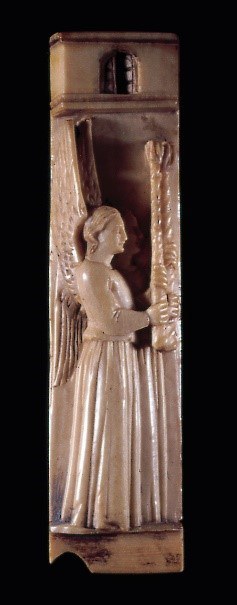17. Bone Angels Panel
Tudor & Stewart World in 100 Objects

Over 19,000 objects have been excavated from the wreck of Henry VIII’s warship, the Mary Rose, which sank during the Battle of the Solent in 1545. Amongst those objects is a bone panel, 113mm long, 28mm wide and 9mm deep. It features two angels, walking in procession from left to right, carrying processional candles, in front of a building with a shuttered window, suggesting it is part of a larger piece of devotional art, perhaps a triptych, which comprises a central panel bearing a religious scene, either painted or carved, with two folding leaves closing over it like doors.
Other types of carvings are diptychs, which open like a book to show the scene and reliquaries, which often consist of caskets for the relic, with carved panels forming the decoration. The most valuable carvings were made of ivory, but its expense made bone a frequently used alternative.
The styling of the bone angels carving suggests that it was a panel from a triptych or a casket carved in the Embriachi workshop, established in Florence by Baldassare degli Embriachi, perhaps as early as 1370, along with his chief workman, Giovanni di Jacopo, and his sons, Antonio and Giovanni Embriachi. By the mid-1390s, the workshop had probably moved to Venice, where the family is recorded up to the early 1430s, although a branch remained in Florence.
As well as luxury religious art, the Embriachi produced more domestic items, particularly marriage chests (cassone) which were important markers of status in Italy. Horse or ox bone were the Embriachi workshops most frequently used materials for bone carving. If the Mary Rose bone angel panel did emanate from the Venetian Embriachi workshop, it must have been at least 112 years old when it was taken on board – suggesting it was a much-treasured family heirloom.
This Italian provenance is supported by the location of the panel in the Mary Rose – within a chest containing other artefacts. Recent isotype analysis of the chest’s probable owner suggests he was of Mediterranean coastal origin, perhaps Italian. Since only higher ranks brought chests to sea, its owner is likely to have been one of the Mary Rose’s officers.
The Embriachi workshops were prolific and other examples can be found in the Metropolitan Museum of Art, the Victoria and Albert Museum, the Ashmolean Museum, Oxford and the Fitzwilliam Museum, Cambridge, amongst others.
The panel and other objects within the chest can be seen in the Mary Rose Museum and the panel features in the ‘Many Faces of Tudor England’ exhibition at the Mary Rose Museum, Portsmouth. A 3-D image of the panel can be seen here
